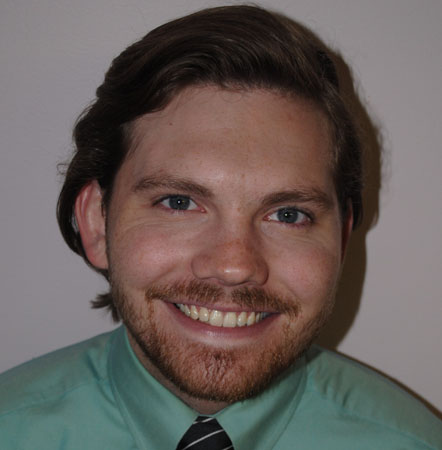
Dakota Palmer
E-MAIL: [email protected]
PhD 2023
PhD Thesis
Roles of Ventral Pallidum Projections to the Ventral Tegmental Area in Cue-elicited Reward Seeking
Current Position:
Lead Coordinator, Human Factors at Baxter Scientific
Undergraduate Institution and Major:
Old Dominion University, B.S. in Biology and Psychology, 2018
Graduate Advisor:
Jocelyn Richard, Ph.D., Department of Neuroscience
Graduate Publcations
- Ventral pallidum neurons projecting to the ventral tegmental area reinforce but do not invigorate reward-seeking behavior. Cell Rep. 2024 Jan 8;43(1):113669.
- Ventral pallidal GABAergic neuron calcium activity encodes cue-driven reward seeking and persists in the absence of reward delivery. J Neurosci. 2023 Jun 16:JN-RM-0013-23.
Graduate Research:
I am currently using fiber photometry to dissect the functional circuitry of the ventral pallidum in motivated behavior.
Research Categories
- Behavioral and Cognitive Neuroscience
- Neuroimaging and Optogenetics
- Neuroscience of Drug Abuse and Addiction
Rotations:
Matthew Johnson, Ph.D., Department of Biomedical Engineering
Gordon Smith, Ph.D., Department of Neuroscience
Jocelyn Richard, Ph.D., Department of Neuroscience
Prakash Kara, Ph.D., Department of Neuroscience
Undergraduate or Post-Bac Research:
My undergraduate research at Old Dominion University was split between two domains. In Dr. Yusuke Yamani’s lab, we were concerned with how cognitive and perceptual processes limit human performance in applied contexts, such as driving a vehicle. In this lab, I studied visual attention and human-automation interaction, with the goal of optimizing performance. I also worked in Dr. Venkat Maruthamuthu’s lab, where we studied the mechanobiology of cell adhesion and migration. In this lab, I studied cell migration of 3T3 cells along micropatterned hydrogel substrates with varying stiffness and helped refine mechanobiology experimental protocols.
Undergraduate Publications/Abstracts:
- Karpinsky ND, Chancey ET, Palmer DB, Yamani Y. Automation trust and attention allocation in multitasking workspace. Appl Ergon. 2018;70:194-201.
- Yamani Y, Bicaksiz P, Palmer DB, Hatfield N, Samuel S. Evaluation of the effectiveness of a gaze-based training intervention on latent hazard anticipation skills for younger drivers: A driving simulator study. Safety 2018, 4(2),18;doi:10.3390/safety4020018.
- Bashirzadeh Y*, Chatterji S*, Palmer D*, Dumbali S, Qian S, Maruthamuthu V. Stiffness measurement of soft silicone substrates for mechanobiology studies using a widefield fluorescence microscope. J Vis Exp. 2018 Jul 3;(137). doi: 10.3791/57797. (*equal contribution).
- Palmer DB, Yamani Y, Bobrow TL, Karpinsky ND, Krusienski DJ. Transient signals and inattentional blindness in a multi-object tracking task.Iperception. 2018;9(1):2041669518754595.
- Maruthamuthu V, Eftekharjou M, Palmer D, McCoy B. Fibrillar force generation by fibroblasts depends on microenvironmental stiffness. Poster presented at the American Society for Cell Biology/European Molecular Biology Organization 2017 Meeting, Philadelphia, PA, 2017.
- Palmer D, Bobrow T, Yamani Y, Krusienski D. Inattentional blindness of salient flashing stimuli in a dynamic multi-object tracking task. Poster presented at the 2nd annual Virginia Academy of Science Research Showcase at the Capitol, Richmond, VA, 2017.
- Bobrow T, Palmer D, Yamani Y, Krusienski D. Characterization of SSVEP evoked by moving stimulus for use in inattentional blindness paradigm. Poster presented at the 2017 Virginia Space Grant Consortium Student Research Conference, Williamsburg, VA, 2017
- Palmer D. Impacts of workload on trust in imperfect automated systems. Poster presented at the University of Virginia’s 10th annual L. Starling Reid Undergraduate Psychology Research Conference, Charlottesville, VA, 2016
What Got You Interested In Research?
I became interested in research during my high school Intro to Psychology course. Many psychology experiments we discussed (e.g. Pavlov; Hubel & Wiesel; Simons & Chabris) fascinated me. I realized that advances in technology during my lifetime would enable us to answer questions no one has ever been able to address before and that I wanted to be a part of it.
Why Did You Choose MN?
The Graduate Program in Neuroscience has a large pool of faculty with some of the most diverse research interests I’ve seen in a program. During the interview weekend, I got a sense that UMN has a genuine collaborative atmosphere and that students were well-supported. Itasca also seemed like a really nice transition into graduate school life.
Student Mentor and the Best Advice They Gave:
Carlee Toddes, when I asked for advice about Itasca: “Bring bug spray, make sure you take time to be on the lake, and don’t take it too seriously.”
Favorite Itasca Memory:
Watching the Perseid meteor shower during our first weekend campfire.
